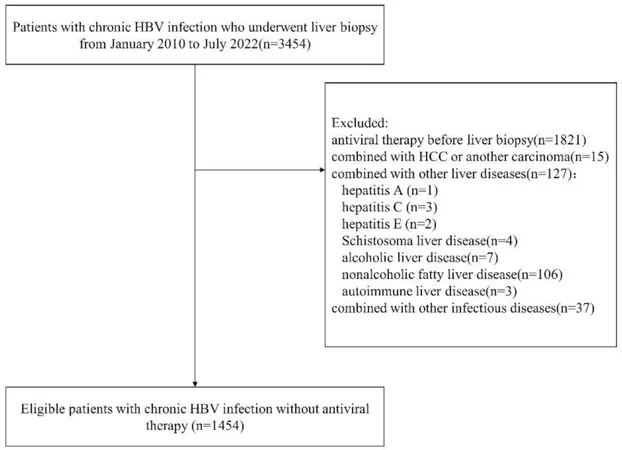
Unveiling the Secrets Behind Chronic Hepatitis B: A Comprehensive Study on the Grey Zone
2025-03-19
Author: Yu
Introduction: Understanding the Grey Zone in Chronic HBV Infection
Chronic Hepatitis B Virus (HBV) infections can often leave patients and clinicians in a state of uncertainty, especially when dealing with what is termed the "Grey Zone." Recent extensive research conducted among 1,454 patients in Shanghai has revealed striking insights regarding the biopsies and histological traits of patients grappling with chronic HBV infection.
Patient Selection and Study Criteria
This study encompassed a staggering total of 3,454 patients who underwent liver biopsies from January 2010 to July 2022 at the Shanghai Public Health Clinical Center. Following stringent inclusion and exclusion criteria, 1,454 patients were selected for detailed analysis. Critical factors such as serum HBeAg, HBV DNA, and ALT levels were closely monitored prior to the biopsies to assess liver inflammation and fibrosis levels, which are crucial for determining the need for antiviral therapy.
Histological Assessment: The Role of Experienced Pathologists
Biopsy specimens were analyzed by two independent liver pathologists who were blinded to the patient's clinical data. Using the Scheuer scoring system, the pathologists classified liver inflammation and fibrosis into defined stages, with significant liver histological changes (SLHC) categorized as grade ≥ G2 or stage ≥ S2.
Diving Deeper Into the Grey Zone
Among the patient pool, 47.5% were categorized as falling into the Grey Zone, defined by specific serum markers that don't completely align with conventional categories of HBV infection. In-depth histological examinations highlighted that 46.7% of patients within this Grey Zone displayed significant liver changes, underlining a stark need for targeted management strategies.
Clinical Characteristics: A Closer Look at Immune Phases
The study reported diverse distributions in clinical characteristics across different immune phases and Grey Zone subgroups. For instance, the majority of identified patients were male, with the highest proportion of liver histological changes notably prevalent among individuals in the IA-GZ-1 subgroup. These insights reinforce the necessity for a nuanced understanding of chronic HBV infection stages to tailor appropriate therapeutic interventions.
The Urgency for Antiviral Treatments
Significantly, the research identifies a clear need for antiviral therapy among various subgroups in the Grey Zone. Specifically, young patients under 30 years old in the IC-GZ group exhibited high rates of SLHC, urging the need for consideration of antiviral treatment. Meanwhile, older patients presenting with increased liver inflammation and fibrosis linked to other groups also necessitated intervention.
Comparative Analysis With Previous Studies
This study compares the results with other findings in the field, highlighting disparities and similarities in SLHC prevalence rates. Previous research suggested percentages reaching as high as 75% in certain subsets of patients, raising questions about consistency in HBV categorization and treatment protocols across different patient cohorts.
Defining Future Pathways in Treatment
The findings from this study aim to inform clinical practice by highlighting the need for careful review of patient history and symptoms. Additionally, providing patients in the Grey Zone with options such as liver biopsies instead of immediate antiviral treatments can foster more effective management strategies.
Conclusion: Navigating the Complex Landscape of Chronic HBV
This extensive study reveals that nearly half of the patients in the Grey Zone exhibit significant liver histological changes, which necessitates immediate clinical awareness and proactive treatment measures. The recommendations for antiviral therapy highlight the healthcare community's responsibility to refine approaches for managing chronic HBV infections, ultimately aiming to improve patient outcomes.
As researchers continue to unveil the complexities of chronic HBV, the call for tailored therapeutic strategies becomes increasingly urgent, particularly for patients stuck in the muddled middle of the Grey Zone. Stay vigilant, as these findings could reshape the understanding and treatment of chronic hepatitis B.
 Brasil (PT)
Brasil (PT)
 Canada (EN)
Canada (EN)
 Chile (ES)
Chile (ES)
 Česko (CS)
Česko (CS)
 대한민국 (KO)
대한민국 (KO)
 España (ES)
España (ES)
 France (FR)
France (FR)
 Hong Kong (EN)
Hong Kong (EN)
 Italia (IT)
Italia (IT)
 日本 (JA)
日本 (JA)
 Magyarország (HU)
Magyarország (HU)
 Norge (NO)
Norge (NO)
 Polska (PL)
Polska (PL)
 Schweiz (DE)
Schweiz (DE)
 Singapore (EN)
Singapore (EN)
 Sverige (SV)
Sverige (SV)
 Suomi (FI)
Suomi (FI)
 Türkiye (TR)
Türkiye (TR)
 الإمارات العربية المتحدة (AR)
الإمارات العربية المتحدة (AR)